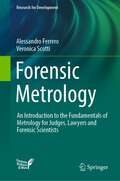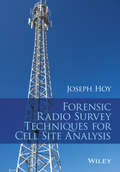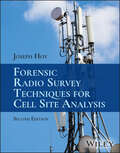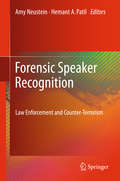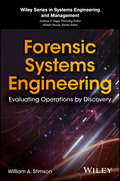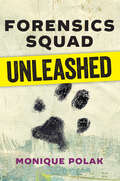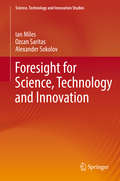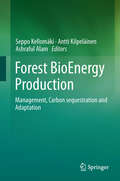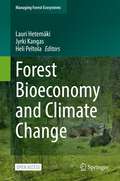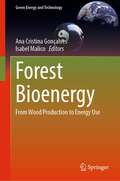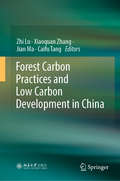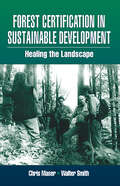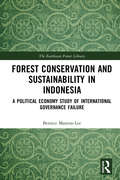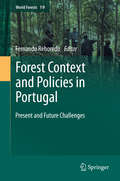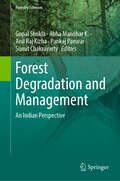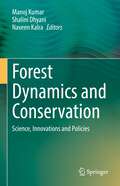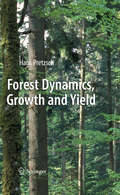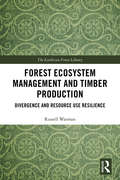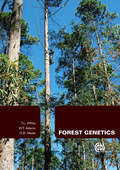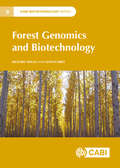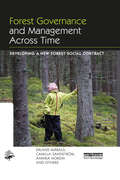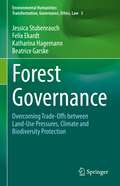- Table View
- List View
Forensic Media: Reconstructing Accidents in Accelerated Modernity
by Greg SiegelIn Forensic Media, Greg Siegel considers how photographic, electronic, and digital media have been used to record and reconstruct accidents, particularly high-speed crashes and catastrophes. Focusing in turn on the birth of the field of forensic engineering, Charles Babbage's invention of a "self-registering apparatus" for railroad trains, flight-data and cockpit voice recorders ("black boxes"), the science of automobile crash-testing, and various accident-reconstruction techniques and technologies, Siegel shows how "forensic media" work to transmute disruptive chance occurrences into reassuring narratives of causal succession. Through historical and philosophical analyses, he demonstrates that forensic media are as much technologies of cultural imagination as they are instruments of scientific inscription, as imbued with ideological fantasies as they are compelled by institutional rationales. By rethinking the historical links and cultural relays between accidents and forensics, Siegel sheds new light on the corresponding connections between media, technology, and modernity.
Forensic Metrology: An Introduction to the Fundamentals of Metrology for Judges, Lawyers and Forensic Scientists (Research for Development)
by Alessandro Ferrero Veronica ScottiThis book offers up-to-date information and guidance on the application of metrology in legal proceedings, clarifying the limits of validity of scientific evidence and presenting an illuminating series of case studies in which measurement uncertainty has played an important role. The fundamental concepts of metrology are discussed, and it is explained how metrology is capable of quantifying the reliability of measurement results and thereby contributing to appropriate decision making. With the aid of the presented case studies, this book will assist readers in understanding how legal decisions should be made in the presence of uncertainty. Areas covered in those studies include breath alcohol concentration analysis, and DNA profiling. Nowadays, decisions in most legal cases are based on evidence obtained through scientific analysis involving the acquisition of accurate measurements. Against this background, Forensic Metrology will be of value for lawyers and judges in both civil and common law countries, as well as engineers and other scientists with an interest in the subject.
Forensic Radio Survey Techniques for Cell Site Analysis
by Joseph HoyThis book is intended to be used as both a text book and as an aide memoire handbook by forensic radio survey engineers, particularly those working for official police agencies. The book provides a simple but detailed overview of the operation of cellular networks (GSM, UMTS and LTE, US CDMAOne/CDMA2000, amongst others). In addition, the author also provides an overview of the technical theories that underpin cellular radio systems - basic radio theory and a simple explanation of the mathematical concepts that underlie measurements scales such as dB and dBm. The main part of the book, however, focuses on radio surveys, the various types of survey, the techniques employed for each survey and the considerations and potential problems that can be encountered when surveying different types of network. The final section deals with processing and interpreting the results of radio surveys and examines the information that can be gained from them.
Forensic Radio Survey Techniques for Cell Site Analysis
by Joseph HoyFORENSIC RADIO SURVEY TECHNIQUES FOR CELL SITE ANALYSIS Overview of the end-to-end process of planning, undertaking, and reporting of forensic radio surveying to support cell site analysis The newly updated and revised Second Edition of Forensic Radio Survey Techniques for Cell Site Analysis provides an overview of the end-to-end process of planning, undertaking, and reporting of forensic radio surveying to support the forensic discipline of cell site analysis. It starts by recapping and explaining, in an accessible way, the theory, structure, and operation of cellular communications networks, then moves on to describe the techniques and devices employed to undertake forensic radio surveys. Worked examples are used throughout to demonstrate the practical steps required to plan and undertake forensic radio surveys, including the methods used to analyze radio survey data and compile it into a court report. A summary section condenses the technical and practical elements of the book into a handy reference resource for busy practitioners. The Second Edition contains 25% brand new material covering 5G New Radio networks and ‘6G and beyond,’ critical communications, mobile satellite communications, IoT networks, Cell Site Analysis Tools, and much more. Other sample topics covered in Forensic Radio Survey Techniques for Cell Site Analysis include: Radio theory, covering RF propagation, basic terminology, propagation modes, multipath transmission, and carrying information on a radio signal Core networks, including 2G, 3G, 4G, and 5G, subscriber and device identifiers, and international and temporary mobile subscriber identities Cell access control, covering cell barring, forbidden LAC/TAC, location updating, inter- and intra-carrier handovers, and 3GPP network types Forensic radio surveys objectives, terminology, and types, along with location, static spot, and indoor surveys The Second Edition of Forensic Radio Survey Techniques for Cell Site Analysis is an essential reference on the subject for police analysts, practitioners, technicians, investigators, and cell site experts, along with legal professionals and students/trainees in digital forensics.
Forensic Speaker Recognition
by Amy Neustein Hemant A. PatilForensic Speaker Recognition: Law Enforcement and Counter-Terrorism is an anthology of the research findings of 35 speaker recognition experts from around the world. The volume provides a multidimensional view of the complex science involved in determining whether a suspect's voice truly matches forensic speech samples, collected by law enforcement and counter-terrorism agencies, that are associated with the commission of a terrorist act or other crimes. While addressing such topics as the challenges of forensic case work, handling speech signal degradation, analyzing features of speaker recognition to optimize voice verification system performance, and designing voice applications that meet the practical needs of law enforcement and counter-terrorism agencies, this material all sounds a common theme: how the rigors of forensic utility are demanding new levels of excellence in all aspects of speaker recognition. The contributors are among the most eminent scientists in speech engineering and signal processing; and their work represents such diverse countries as Switzerland, Sweden, Italy, France, Japan, India and the United States. Forensic Speaker Recognition is a useful book for forensic speech scientists, speech signal processing experts, speech system developers, criminal prosecutors and counter-terrorism intelligence officers and agents.
Forensic Systems Engineering: Evaluating Operations by Discovery
by William A. StimsonA systems-level approach to reducing liability through process improvement Forensic Systems Analysis: Evaluating Operations by Discovery presents a systematic framework for uncovering and resolving problematic process failures. Carefully building the causal relationship from process to product, the discussion lays out in significant detail the appropriate and tactical approaches necessary to the pursuit of litigation with respect to corporate operations. Systemic process failures are addressed by flipping process improvement models to study both improvement and failure, resulting in arguments and methodologies relevant to any product or service industry. Guidance on risk analysis of operations combines evaluation of process control, stability, capability, verification, validation, specification, product reliability, serial dependence, and more, providing a robust framework with which to target large-scale nonconforming products and services. Relevant to anyone involved in business, manufacturing, service, and control, this book: Covers process liability and operations management from both engineering and legal perspectives Offers analyses that present novel uses of traditional engineering methods concerning risk and product quality and reliability Takes a rigorous approach to system tactics and constraints related to product and service operations and identifies dysfunctional processes Offers both prescriptive and descriptive solutions to both the plaintiff and the defendant The global economy has created an environment in which huge production volume, complex data bases, and multiple dispersed suppliers greatly challenge industrial operations. This informative guide provides a practical blueprint for uncovering problematic process failures.
Forensics Squad Unleashed
by Monique PolakTabitha is thrilled to be attending a summer forensics camp, especially when she gets the opportunity to use her newfound skills to solve a real-life mystery in this novel for teens.
Foresight for Science, Technology and Innovation
by Ian Miles Alexander Sokolov Ozcan SaritasDecision-makers at all levels are being confronted with novel complexities and uncertainties and face long-term challenges which require foresight about long-term future prospects, assumptions, and strategies. This book explores how foresight studies can be systematically undertaken and used in this context. It explicates why and how methods like horizon scanning, scenario planning, and roadmapping should be applied when dealing with high levels of uncertainty. The scope of the book moves beyond "narrow" technology foresight, towards addressing systemic interrelations between social, technological, economic, environmental, and political systems. Applications of foresight tools to such fields as energy, cities, health, transportation, education, and sustainability are considered as well as enabling technologies including nano-, bio-, and information technologies and cognitive sciences. The approaches will be illustrated with specific actual cases.
Forest BioEnergy Production
by Seppo Kellomäki Antti Kilpeläinen Ashraful AlamFor thousands of years, forest biomass or wood has been among the main energy sources of humans around the world. Since the industrial revolution, fossil fuels have replaced wood and become the dominant source of energy. The use of fossil fuels has the disadvantage of increasing atmospheric concentrations of greenhouse gases (GHGs), especially carbon dioxide (CO2), with the consequent warming of global climate and changes in precipitation. In this context, the substitution of fossil fuels with renewable energy sources like forest biomass is among the ways to mitigate climate change. This book summarizes recent experiences on how to manage forest land to produce woody biomass for energy use and what are the potentials to mitigate climate change by substituting fossil fuels in energy production. In this context, the book addresses how management can affect the supply of energy biomass using short-rotation forestry and the conventional forestry applying long rotations. Furthermore, the book outlines the close interaction between the ecological systems and industrial systems, which controls the carbon cycle between the atmosphere and biosphere. In this context, sustainable forest management is a key to understand and control indirect carbon emissions due to the utilization of forest biomass (e. g. from management, harvesting and logistics, and ecosystem processes), which are often omitted in assessing the carbon neutrality of energy systems based on forest biomass. The focus in this book is on forests and forestry in the boreal and temperate zones, particularly in Northern Europe, where the woody biomass is widely used in the energy industry for producing energy.
Forest Bioeconomy and Climate Change (Managing Forest Ecosystems #42)
by Jyrki Kangas Lauri Hetemäki Heli PeltolaThis edited open access volume explores the role of forest bioeconomy in addressing climate change. The authors put a particular focus on planetary boundaries and how the linear, growth-oriented economy, is coupled with climate change and environmental degradation. Biobased products and sustainable production paths have been developed, but how can they be scaled in order to lead to an economic paradigm shift? This and other questions are discussed throughout the volume.Since science indicates that climate change will continue this century, the authors also analyse how forests can be adapted to increasing forest disturbances that changing climate are expected to cause. The authors propose climate-smart forestry as useful approach for climate mitigation and adaptation of forests to climate change, as wells as sustainable increase of economic well-being based on forestry. The book illustrates the application of climate-smart forestry in the Czech Republic, Finland, Germany and Spain, i.e., in EU countries with quite different forests and forest sectors. This proactive and inspiring volume is an essential resource for Forest Management professionals, decision makers, scientists, and forestry students.
Forest Bioenergy: From Wood Production to Energy Use (Green Energy and Technology)
by Ana Cristina Gonçalves Isabel MalicoThis book is a comprehensive overview of the forest bioenergy, from feedstock production to end products. The book presents the state of the art of forest biomass production, assessment, characterization, and conversion into heat and power. It starts with forest sources of biomass and potential availability. Continues with the characterization of the forest stands and the availability of biomass for energy per stand structure, including stands managed for timber, non-wood products, and energy plantations. It follows with biomass evaluation and monitoring considering data sources, modeling methods, and existing models. are also addressed. After the initial focus on forest biomass production and estimation, this resource is assessed as a feedstock for energy conversion. Not only current, but also emerging biofuels obtained from forest biomass are considered. Established and emerging conversion technologies for the production of bio-heat and bio-power are examined and the impacts of the conversion systems presented.
Forest Carbon Practices and Low Carbon Development in China
by Zhi Lu Jian Ma Xiaoquan Zhang Caifu TangThis is the first book illustrating China’s forest carbon projects. It includes an analysis of the policy and future development trends of China’s forest carbon market and showcases the country’s most representative forest carbon projects. Accordingly, it offers a valuable resource for all policymakers and researchers interested in forest carbon, as well as project developers and engineers involved in forest carbon projects.
Forest Certification in Sustainable Development: Healing the Landscape
by Chris Maser Walter SmithFrom recycled products to organic food, the movement to be "environmentally friendly" is now expanding into the forestry field. Recognizing this impact, Home Depot has committed to giving preference to selling "certified wood," proven to come from forests that meet certain biological and social sustainablility standards. Retailers and vendors can o
Forest Certification: Roots, Issues, Challenges, and Benefits
by Bruce C. Larson John C. Gordon Anna Fanzeres Daniel J. Vogt Kristiina A. VogtForest Certification examines the historical roots of forest certification, the factors that guide the development of protocols, the players involved, the factors determining the customers to be certified, and the benefits of certification. It covers terminology and issues that direct the structure of standards, the similarities between indicators of different human disturbances within the ecosystem/landscape, and certification standards. It documents the roles of human values in the development of assessment protocols and demonstrates how elements should be used to produce non-value based standards.
Forest Conservation and Sustainability in Indonesia: A Political Economy Study of International Governance Failure (The Earthscan Forest Library)
by Bernice Maxton-LeeDespite carefully constructed conservation interventions, deforestation in Indonesia is not being stopped. This book identifies why large-scale international forest conservation has failed to reduce deforestation in Indonesia and considers why key stakeholders have not responded as expected to these conservation interventions. The book maps the history of deforestation in Indonesia in the context of global political economy, exploring the relationship between international trade, the interests and ideology behind global sustainability programmes and the failures of forest conservation in Indonesia. Global economic and political ideologies are shown to have profoundly shaped deforestation. The author argues that the same forces continue to prevent positive outcomes. Case study chapters analyse three major international programmes: Reducing Emissions from Deforestation and Forest Degradation (REDD+), the Norway-Indonesia bilateral partnership, and the Roundtable on Sustainable Palm Oil (RSPO) in Indonesia. The findings provide insight into the failures of global climate change policy and suggest how the book’s theoretical model can be used to analyse other complex environmental problems. The book is a useful reference for students of environmental science and policy, political theory, international relations, development and economics. It will also be of interest to forestry professionals and practitioners working in NGOs.
Forest Context and Policies in Portugal
by Fernando ReboredoThis book provides an up-to-date analysis of the Portuguese forests and forestry sector, including its history, its total economic value, current threats and opportunities and future challenges, namely the need to incorporate more planning and technology in forest management practices. The methodological approach of analysing the forestry sector in terms of its total economic value, and the use of this new perspective to correctly perceive the forest sector and to base development strategies is unique. Also, the use of new methods and technologies in the Portuguese forestry sector will be an opportunity to share these experiences with a wider international audience. For example, fire incidence during the summer has almost no parallel in the Western World, implying that Portuguese forest landscapes function as a "natural lab of wildfires" from which much can be learned globally. Thus, the outcomes of the fire management policies adopted might represent important lessons for Mediterranean basin countries.
Forest Degradation and Management: An Indian Perspective (Forestry Sciences #87)
by Gopal Shukla Sumit Chakravarty Pankaj Panwar Abha Manohar K. Anil Raj KizhaForest Degradation and Management - An Indian Perspective provides an overview of the dynamics and challenges surrounding forest degradation in India. It reveals the harmful impacts of human activity on natural resources, ecosystems, and communities, and emphasizes the urgent need for sustainable forest management practices. The book is divided into four parts, each offering a different perspective on forest degradation. Part I presents an overview of forest degradation in India, including a comparative analysis of assessment tools. Part II explores the ecological impacts of forest degradation on ecosystems. Part III is dedicated to societal aspects, examining the consequences of human activity such as cultivation, eco-tourism, resource utilization, and deforestation, while also analyzing the impact of forest degradation on forest-dependent communities. Part IV focuses on mitigation strategies, highlighting the role of protected areas, governance, policies, and participatory approaches. This volume within the book series Forestry Sciences is an invaluable resource for students, researchers, policymakers, and conservationists seeking to tackle the complex challenges of forest degradation. It provides knowledge and practical insights to inform decision-making processes, guide sustainable forest management strategies, and promote responsible land use practices.
Forest Dynamics and Conservation: Science, Innovations and Policies
by Manoj Kumar Shalini Dhyani Naveen KalraThis book unveils forestry science and its policy and management that connect past and present understanding of forests. The aggregated knowledge is presented to cover the approaches adopted in studying forest structure, its growth, functioning, and degradation, especially in the context of the surrounding environment. The application of advance computation, instrumentation, and modelling has been elaborated in various chapters.Forest ecosystems are rapidly changing due to forest fires, deforestation, urbanization, climate change, and other natural and anthropogenic drivers. Understanding the dynamics of forest ecosystems requires contemporary methods and measures, utilizing modern tools and big data for developing effective conservation plans. The book also covers discussion on policies for sustainable forestry, agroforestry, environmental governance, socio-ecology, nature-based solutions, and management implication. It is suitable for a wide range of readers working in the field of scientific forestry, policy making, and forest management. In addition, it is a useful material for postgraduate and research students of forestry sciences.
Forest Dynamics, Growth and Yield
by Hans PretzschThe aim of this book is to improve the understanding of forest dynamics and the sustainable management of forest ecosystems. How do tree crowns, trees or entire forest stands respond to thinning in the long term? What effect do tree species mixtures and multi-layering have on the productivity and stability of trees, stands or forest enterprises? How do tree and stand growth respond to stress factors such as climate change or air pollution? Furthermore, in the event that one has acquired knowledge about the effects of thinning, mixture and stress, how can one make that knowledge applicable to decision-making in forestry practice? The experimental designs, analytical methods, general relationships and models for answering questions of this kind are the focus of this book. Given the structures dealt with, which range from plant organs to the tree, stand and enterprise levels, and the processes analysed in a time frame of days or months to decades or even centuries, this book is directed at all readers interested in trees, forest stands and forest ecosystems. This work has been compiled for students, scientists, lecturers, forest planners, forest managers, and consultants.
Forest Ecosystem Management and Timber Production: Divergence and Resource Use Resilience (The Earthscan Forest Library)
by Russell WarmanTimber sourcing is shifting from extraction from natural forests to forms of cultivation that are increasingly agricultural in nature. This book takes a multidisciplinary approach to examine the socio-political, biophysical and discursive dimensions of this divergence of wood production from forests. This analysis challenges the historical integration of wood production and forest ecosystem management exemplified by the institutions of forestry with their inherent wood/forest connection. This has significant implications for how wood and forest socio-ecological systems confront change and challenge ideas about how to achieve sustainability. Historically, the institutions of stewardship forestry were founded on ideals of sustainable systems in long-term equilibrium. However, these occur within rapidly evolving social and technological contexts that constantly challenge the maintenance of any equilibrium. This creates considerable tension within wood and forest socio-ecological systems and their institutions and governance. Moving beyond adaptation to transformation, however, requires a willingness to consider post-forestry conditions, such as integration of emerging wood cultivation systems into agricultural and landscape approaches, and increasing management of extensive forest ecosystems for non-wood values in the absence of wood production. This book includes four case studies: a global modelling of shifts in wood production and three national case studies (Australia, Indonesia and New Zealand), each analysing shifts in resilience in wood and forest socio-ecological systems using a different disciplinary approach. This book will be of interest to advanced students, researchers and professionals in forestry, land use, conservation, rural studies and geography.
Forest Entomology and Pathology: Volume 1: Entomology
by Bernard Slippers Jeremy D. Allison Timothy D. Paine Michael J. WingfieldThis open access book will provide an introduction to forest entomology, the principles and techniques of forest insect pest management, the different forest insect guilds/feeding groups, and relevant forest insect pest management case studies. In addition to covering 30% of the earth, forest ecosystems provide numerous timber and non-timber products that affect our daily lives and recreational opportunities, habitat for diverse animal communities, watershed protection, play critical roles in the water cycle, and mitigate soil erosion and global warming. In addition to being the most abundant organisms in forest ecosystems, insects perform numerous functions in forests, many of which are beneficial and critical to forest health. Conversely, some insects damage and/or kill trees and reduce the capacity of forests to provide desired ecosystem services. The target audience of this book is upper-level undergraduate and graduate students and professionals interested in forest health and entomology.
Forest Genetics
by Timothy White W Adams David NealeWinner of a 2009 Outstanding Academic Title (OAT) award ! Trees continue to maintain a unique significance in the social, ecological and economic systems of the world - as large, long-lived perennials covering 30% of land on Earth; their very nature dictates their importance. An understanding of forest genetics is essential for providing insight into the evolution, conservation, management and sustainability of both natural and managed forests.Providing a comprehensive introduction to the principles of genetics as important to forest trees, this text integrates the varied sub-disciplines of genetics and their applications in gene conservation, tree improvement and biotechnology. Topics discussed include genetic variation in natural forest trees, the application of genetics in tree improvement and breeding programs, and genomic sciences and molecular technologies.
Forest Genomics and Biotechnology (CABI Biotechnology Series)
by Richard Meilan Matias KirstDevelopments in genomics and biotechnology are opening up new avenues for accelerating the domestication of forest trees in a climate change driven world. This book presents an authoritative update of forest tree biotechnology and genomics methodologies, procedures and accomplishments, from basic biological science to applications in forestry and related sciences. It gives expert evaluation of achievements and discussion about the impact that novel forest biotechnological and genomics approaches are having on traditional breeding for improvement of forest tree species and production of forest-based products. It also describes the legal and regulatory aspects of forest biotechnology, with an emphasis on biosafety. It is a reference for forest biologists, including basic and applied scientists involved in forest tree breeding and biotechnology, bioenergy research, and biomaterial product development. Key features: Advances in tree genomic selection. Next-generation sequencing technologies. Domesticating forest-tree species via genetic engineering. Regulatory affairs related to forest biotechnology. Protecting intellectual property. This title is suitable for graduate-level students working in plant biology and forest genetics, silviculture and agroforestry, and bioenergy science and technology. It is also relevant to scientists and foresters researching genetics, genomics and biotechnology, molecular biology and physiology of forest trees, and their application to production forestry, and conservation, as well as for sustainable forestry for bioenergy and bio-based products.
Forest Governance and Management Across Time: Developing a New Forest Social Contract (The Earthscan Forest Library)
by Erland Mårald Camilla Sandstrom Annika Nordin and OthersThe influence of the past, and of the future on current-time tradeoffs in the forest arena are particularly relevant given the long-term successions in forest landscapes and the hundred years’ rotations in forestry. Historically established path dependencies and conflicts determine our present situation and delimit what is possible to achieve. Similarly, future trends and desires have a large influence on decision making. Nevertheless, decisions about forest governance and management are always made in the present – in the present-time appraisal of the developed situation, future alternatives and in negotiation between different perspectives, interests, and actors. This book explores historic and future outlooks as well as current tradeoffs and methods in forest governance and management. It emphasizes the generality and complexity with empirical data from Sweden and internationally. It first investigates, from a historical perspective, how previous forest policies and discourses have influenced current forest governance and management. Second, it considers methods to explore alternative forest futures and how the results from such investigations may influence the present. Third, it examines current methods of balancing tradeoffs in decision-making among ecosystem services. Based on the findings the authors develop an integrated approach – Reflexive Forestry – to support exchange of knowledge and understandings to enable capacity building and the establishment of common ground. Such societal agreements, or what the authors elaborate as forest social contracts, are sets of relational commitment between involved actors that may generate mutual action and a common directionality to meet contemporary challenges.
Forest Governance: Overcoming Trade-Offs between Land-Use Pressures, Climate and Biodiversity Protection (Volume 3) (Environmental Humanities: Transformation, Governance, Ethics, Law)
by Katharina Hagemann Felix Ekardt Jessica Stubenrauch Beatrice GarskeThis book analyses and develops overarching concepts for forest policy and forest governance and includes a detailed investigation into the historical discussion on forests. It examines opportunities and limits for negative emissions in a sector that – like peatlands – appears significantly less ambivalent compared to highly technical large-scale forms of climate geoengineering. The analysis shows that the binding climate and biodiversity targets under international law are much more ambitious than most people assume. Measured against that, the volume critically reviews the potentials of afforestation and reforestation for climate mitigation, which is often presented as the new saviour to fulfil the commitments of the Paris Agreement and to reach climate neutrality in the future. It becomes clear that ultimately only biodiverse and thus resilient forests can function as a carbon sink in the long term. The volume shows that the existing European and international forest governance approaches fail to comply with these targets and insights. Furthermore, the book develops a bundle of policy measures. Quantity governance systems for livestock farming, fossil fuels and similar drivers of deforestations represent the most important approach. They are most effective when not directly targeting forests due to their heterogeneity but central damaging factors. With regard to the dominant regulatory and subsidy-based governance for forests we show that it remains necessary to supplement these quantity governance systems with certain easily graspable and thus controllable regulatory and subsidy regulations such as a regulatory protection of old-growth forests with almost no exceptions; extension of the livestock-to-land-ratio established in organic farming to all farming; far-reaching restriction of bioenergy use to certain residues flanked by import bans; and a national and international complete conversion of all agricultural and forest subsidies to “public money for public services” to promote nature conservation and afforestation in addition to the quantity control systems.

